Учебник состоит из трех частей. В частях I и II рассматривается традиционный (классический) для дисциплины "Инженерная и компьютерная графика" материал - элементы начертательной геометрии и основы инженерной графики, необходимые для построения изображений и создания конструкторской документации: основные положения начертательной геометрии, формирующие навыки пространственного представления геометрических объектов; элементы инженерной графики, изучающей правила разработки и чтения технической документации; элементы компьютерной графики, знакомящей с общими принципами создания твердотельных моделей и чертежей.
Часть III знакомит с современным подходом к автоматизированному проектированию изделий, когда конструкторская документация создается на основе трехмерного моделирования этих изделий.
В приложениях представлены тестовые задания, направленные на повышение результативности освоения основ твердотельного моделирования.
Uchebnik sostoit iz trekh chastey. V chastyakh I i II rassmatrivaetsya traditsionnyy (klassicheskiy) dlya distsipliny "Inzhenernaya i kompyuternaya grafika" material - elementy nachertatelnoy geometrii i osnovy inzhenernoy grafiki, neobkhodimye dlya postroeniya izobrazheniy i sozdaniya konstruktorskoy dokumentatsii: osnovnye polozheniya nachertatelnoy geometrii, formiruyushchie navyki prostranstvennogo predstavleniya geometricheskikh obektov; elementy inzhenernoy grafiki, izuchayushchey pravila razrabotki i chteniya tekhnicheskoy dokumentatsii; elementy kompyuternoy grafiki, znakomyashchey s obshchimi printsipami sozdaniya tverdotelnykh modeley i chertezhey. CHast III znakomit s sovremennym podkhodom k avtomatizirovannomu proektirovaniyu izdeliy, kogda konstruktorskaya dokumentatsiya sozdaetsya na osnove trekhmernogo modelirovaniya etikh izdeliy. V prilozheniyakh predstavleny testovye zadaniya, napravlennye na povyshenie rezultativnosti osvoeniya osnov tverdotelnogo modelirovaniya.
The textbook consists of three parts. In parts I and II are considered traditional (classical) for the discipline "Engineering and computer graphics" material - elements of descriptive geometry and engineering graphics fundamentals necessary to build the images and design documentation: the basic provisions of descriptive geometry, forming the skills of spatial representation of geometric objects; elements of engineering graphics, learning the rules of design and technical documentation reading; elements of computer graphics, introduces the General principles of creation of solid models and drawings.
Part III introduces a modern approach to automated design of products when design documentation is created based on three-dimensional modeling of these products.
The appendices contain test tasks aimed at improving the effectiveness of the development of the foundations of solid modeling.

